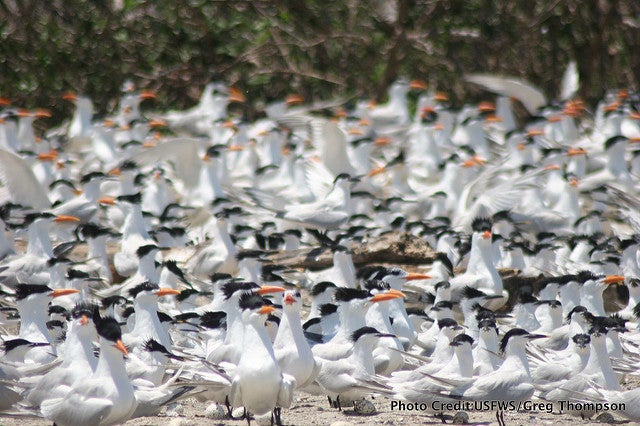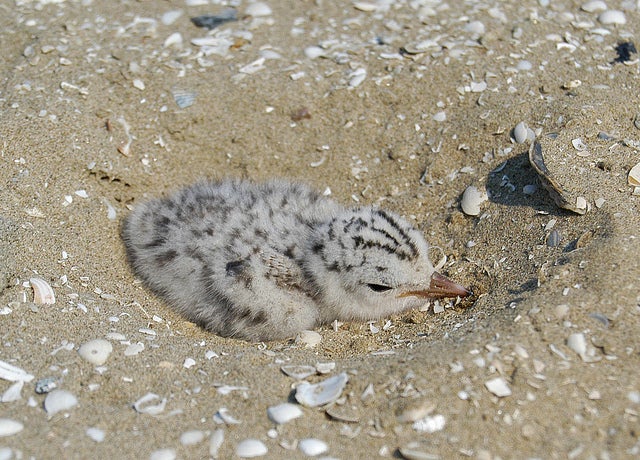Barrier Island Restoration: An Investment in Coastal LA’s Future and for Nesting Seabirds, Part 2
Our partners at Audubon Louisiana published a series of blog posts that we are cross-posting here. View the original blog post here.
As we mark the sixth anniversary of the BP oil spill this week – an event that significantly and negatively impacted Louisiana’s already disappearing barrier islands and the species that depend on them – we will examine the status of barrier island restoration. Over the coming days, we’ll publish a series of blog posts that detail what work has been done to restore Louisiana’s barrier islands, the importance of these islands to birds and humans alike, as well as Audubon Louisiana’s role before, during and after the restoration process to monitor and improve bird health on these islands and elsewhere.
Part 2: “Barrier Islands: A Critical Investment for Bird Health”
As we discussed in the first blog post, coastal Louisiana is rich with bird life, and barrier islands play a central role in the population dynamics of many species. This is particularly true for seabirds that nest on islands, isolated from the mainland and its many mammalian predators. These seabirds live life on the edge of the Earth, and barrier islands are the key to their survival.
So how does the restoration of barrier islands benefit these nesting seabirds? Seabirds, like terns and gulls, as well as some coastal-nesting shorebirds, like Wilson’s Plovers and American Oystercatchers, place their eggs on the ground (although a few species, like Brown Pelicans prefer low shrubs, like mangroves). These nesting birds are not only susceptible to mammalian predators, but also the overwash of storms. As islands and their dune systems erode, nests are inevitably placed closer and closer to the high tide line putting them at greater risk to the overwash of even small storms. Renesting can be possible, but at some point becomes futile. And with fewer and fewer islands available, eventually space runs out, and populations decline. The restoration of these islands increases opportunities and space for placing nests, and helps elevate nests to reduce their chances of overwashing.

Royal Terns, Breton Island Photo: USFWS, Greg Thompson
There is another important consideration for barrier island restoration – for seabirds, bigger is not necessarily better. Anyone who has taken an introduction to ecology course might recall “Island Biogeography Theory”. It suggests that the bigger the island and the closer it is to shore, the more species it can support. This sounds great, right? But those additional species can be (and often are) predators. So for a seabird, smaller islands farther from shore are better. Predators like coyotes, raccoons, rats, skunks, foxes, feral cats, fire ants and even nutria, have a harder time getting to those islands and surviving there. This becomes important when thinking about barrier island restoration. Although there is a clear need to build large islands that protect interior shorelines and communities, this may actually serve as an ecological trap for nesting seabirds. Those larger islands can support more predators, and while the habitat looks perfectly suitable to a Black Skimmer, Least Tern, or Sandwich Tern, it could also be full of predators ready to eat their eggs and chicks.

Least Tern, Elmers Island, Louisiana Photo: Erik Johnson, Audubon Louisiana
As far as we know, only the distant Chandeleur Islands and its neighbors are mostly or entirely free of coyotes, and probably most other kinds of mammalian predators. Louisiana Department of Wildlife and Fisheries surveys last spring documented that these islands were full of nesting seabirds, although probably not in numbers like during the glory days of Curlew Island, which supported tens of thousands of nesting pairs of Sandwich Terns and Royal Terns in the 1970s. Clearly, the commitment of restoration to Breton Island is tremendously important for the recovery of seabirds in coastal Louisiana, as will be the restoration of other nearshore, small (predator-free) bay islands, like Queen Bess in Barataria Bay.
In the next blog, we’ll talk more about how Audubon Louisiana works to protect birds before, during and after barrier island restoration projects.